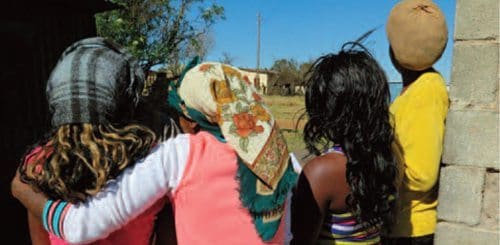South Africa has unacceptably high rates of maternal mortality. Although the country is seeing improvements since 2011, the number of women and girls who are dying during pregnancy or shortly after giving birth has increased dramatically since 2000. Today, the maternal mortality rate stands at 269 deaths per 100,000 live births, far higher than the rate of 38 which the government committed to achieve by 2015. Experts suggest 60% of maternal deaths in South Africa are avoidable.
Appropriate and timely antenatal care plays an important role in improving maternal and child health, and preventing maternal deaths. It aims to detect and treat existing health problems and to screen for complications that may develop in the pregnancy. The World Health Organization (WHO) recommends a minimum of four antenatal care visits, starting in the first 12 weeks of pregnancy. Antenatal care is also an opportunity to provide vital health information to women and girls relating to lifestyle risks and to offer social support and counselling. It connects them with the health system, leading to an increased likelihood of delivery with a skilled birth attendant and continuing care after the baby is born.
Early attendance at antenatal clinics is particularly important for pregnant women and girls living with HIV. Nearly 30% of pregnant women and girls in South Africa are living with HIV, and illnesses related to HIV infection are the biggest cause of death among pregnant women and girls in the country, followed by bleeding during or after childbirth and complications caused by high blood pressure. Women and girls living with HIV are over five times more likely to die during pregnancy or shortly after birth than those without the virus.
The South Africa government has taken commendable efforts to prioritise the need to reduce maternal deaths in recent years through key health policies. These policies recognise the importance of early and continued antenatal care. The government's stated target is for more than 60% of pregnant women and girls to access antenatal care before 20 weeks of pregnancy by 2016. Antenatal care is free in South Africa's public health system and nearly all pregnant women and girls attend an antenatal clinic at least once during their pregnancy. However, most pregnant women do not access antenatal care until the latter stage of pregnancy. Such delays have been linked to nearly a quarter of avoidable maternal deaths in South Africa.
As part of its commitment to reduce maternal deaths, in 2010 the government began providing antiretroviral treatment to pregnant women and girls living with HIV specifically to improve their health during pregnancy. As a result, the rate of maternal deaths has finally begun to decrease. South Africa has also achieved success in preventing the transmission of HIV from pregnant women and girls to the foetus, reducing the number of babies born annually with HIV from 70,000 to under 8,000 within a decade.
This report aims to help identify some of the problems that are contributing to the high number of women and girls who are still dying needlessly each year during pregnancy or shortly after giving birth, and to offer some recommendations for action. Qualitative studies, such as this one, which capture individual testimony from women and girls, provide insight into why early antenatal care is often inaccessible, so policy makers and health care workers can design and implement appropriate policies. In highlighting these barriers, Amnesty International advocates for a human rights based approach to health service planning and implementation.
The research was conducted within a human rights framework, including the State's obligation to respect, protect and fulfil the right to the highest attainable standard of care. This includes the right to accessible health care, and the right to equality and non-discrimination. This report identifies and focuses on three barriers that Amnesty International found contribute to women and girls delaying or avoiding antenatal care, which in turn can contribute to South Africa's high rates of maternal mortality. These are:
- Lack of privacy, patient confidentiality and informed consent at health facilities, especially around the implementation of HIV testing during antenatal care.
- Lack of information and knowledge about sexual and reproductive health and rights, including lack of training on the part of health care workers.
- Persistent problems relating to the availability and costs of transport.
This report also reflects that these barriers were exacerbated for women and girls who experience other challenges, particularly those linked to poverty and gender discrimination that often increase during pregnancy. Women and girls, according to official statistics, are often most disadvantaged by poor standards of housing and sanitation, access barriers to education and lack of secure employment opportunities. High rates of gender-based violence are well documented in South Africa.
Among its recommendations, Amnesty International is calling on the government to:
- Ensure that all branches of government are involved in the response to maternal mortality, HIV and gender-based discrimination, and develop programmes to promote safe pregnancies and deliveries, including by addressing the social and economic challenges women and girls face accessing early antenatal care.
- Ensure that all health system procedures uphold patient confidentiality and enhance non-discrimination, avoiding for instance the use of specific files for HIV treatment, separate queues and designated waiting areas for people living with HIV.
- Take steps to increase awareness about patients' rights, particularly the right to informed consent.
- Improve knowledge about sexual and reproductive health and rights, including through comprehensive sexuality education that involves men and boys.
- Urgently address the persistent lack of safe, convenient and adequate transport, and the poor condition of roads, particularly in rural settings, including through subsidized or free transport, grants to pregnant women and girls to cover transport costs, improving road infrastructure, and improved transport options

